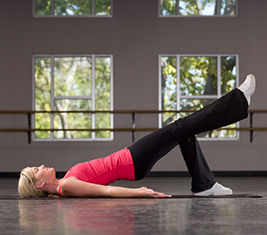
Turns out, you don’t have to be new to be trendy. Such was the case when both the American Council on Exercise and the American College of Sports Medicine separately announced their top fitness trends of 2013. While it may not have surprised you to find things like strength training and core training among the top 10, there was one that stood out: Body-weight training.
The irony? Body-weight training is perhaps the oldest training technique in the book, as our cavemen ancestors no doubt utilized it on a daily basis. Yet in recent years, body-weight training classes, everything from TRX to barre, have been dominating fitness class menus. Why? Plain and simple, it works. Here’s what you need to know to make body-weight training safe and effective for your clients.
Why the Buzz About Body-weight Training
Alex McLean, an international fitness presenter, senior TRX course instructor and featured FitnessGlo.com instructor based in Los Angeles, likes to tell the story of the day his friend asked him to help move. This friend was no weakling, as he was able to bench press an incredible amount of weight. Yet when it came to lifting a heavy piece of furniture, forget it. “He hadn’t trained for real-life movements, and because he didn’t have the bench underneath his body to support him, his strength was limited,” McLean says.

That example perhaps illustrates the main benefit of body-weight training: It preps your body for everyday activities, something Jon Hinds, creator of the Monkey Bar Gym based in Madison, Wis., is passionate about. Monkey Bar workouts, after all, are based solely on body weight, a form of training he believes to be superior to others, especially weight machines. “No machine is going to help you stand up out of a chair, pull yourself up onto something or run after a bus,” he says. “While machines develop strength and power, body-weight training does all of that and goes a step further by developing stability, balance and coordination.”
There are the obvious benefits, too, in that body-weight training is the most convenient form of training. “You can do it anytime, anywhere, and you don’t need any equipment,” McLean says.
It’s also a time-efficient way to train. “It typically uses the whole body or entire muscle systems of the body,” explains John Garey, owner of John Garey Fitness & Pilates in Long Beach, Calif. “As a result, it saves time by training many muscles at a time, allowing for muscles that cross multiple joints to do their job of coordinating movements.”
The Cons of Using Body Weight to Train
Body-weight training, however, doesn’t come without its downsides. Blame it more on operator error, so to speak, whether by clients or trainers, than anything else. The most obvious mistake? Using incorrect form. “Even with a personal trainer, people have trouble maintaining proper form,” McLean says.
There’s also concern that people don’t give their bodies time to adapt to the training, and they go for the hardest methods first. The end result? They either injure themselves or get so turned off by this form of training that they abandon it or quit exercise altogether, Hinds says.
Yet don’t just point the finger at individuals, as the burden lies with trainers, too. “I see a lot of trainers asking clients to do moves that are too advanced for them,” Hinds says. While body-weight training may seem basic, like every training method, it comes with risks. So, before you ask a client to do advanced exercises like plyometric jumps or other tough body-weight moves, you have to make sure his or her body is properly prepared.
Designing Body-weight Training Programs
Experts agree that everybody can benefit from body-weight training, but with one caveat: “Like other training techniques, you have to keep a person’s limitations in mind and know how to modify moves,” Hinds says. To help you design the safest, most effective programs, follow these seven strategies:
1 Don’t think all or nothing. Although you can certainly design entire programs with nothing but body weight, you can also integrate body-weight training into clients’ current training programs. “Just do two to three exercises with them so you can see how they respond and then adjust accordingly,” McLean says.
2 Start with the basics. Before you ask clients to do anything that puts extra load on the body or requires tough balance or stability challenges, let them get good at base exercises first, Hinds says. For instance, before they do dynamic moves like box jumps, they should be good at doing a high volume of one-legged squats. Garey also suggests using less speed and shorter levers to help clients understand the basics and get the right form.

3 Train in all planes. There are three planes of motion, and while most people train mainly in the sagittal plane (moving forward and backward), this isn’t the only movement people do in a day’s time, McLean says. They also move side to side and rotate, so make sure you are programming moves that don’t overemphasize one movement pattern—be aware that it’s easy to do too much pushing and not enough pulling, McLean notes—and incorporate all three planes. Those three planes include the following: sagittal plane (for flexion and extension), frontal plane (for abduction and adduction) and transverse plane (for internal and external rotation).
4 Plan for higher reps. Traditional strength training often relies on eight to 12 reps for general fitness programs. However, Hinds suggests using slightly higher reps than traditional weights to build the same hypertrophy. A good general guideline might be a 10- to 15-rep range. You can then adjust as needed based on your clients’ goals and abilities.
5 Think outside the set-rep box. While you can certainly use sets and reps when designing body-weight training programs, you can also use time to determine how much your clients do, McLean says. For instance, you might suggest your clients do as many reps as possible in a certain time frame, even as short as 10 seconds.
6 Play with variables other than load when progressing clients. “Most trainers are used to progressing clients in terms of load,” McLean says, “but there are so many other variables you can use.” Take, for instance, a 200-pound man who can bench press 250 pounds. How can you translate his strength capacity to body-weight training and still have him be challenged? You could, for example, change his body position, flipping him over and asking him to do push-ups. From there, you can change tempo, maybe having him count four on the way down, hold on the bottom and then push up. You can also change stability so that he brings his hands or feet closer or lifts a leg as he does the push-up. Or what if you asked him to lie on his side and do a one-arm push-up?
7 Track their progress. While people can be obsessive about tracking progress when using traditional weights and machines, they often abandon this practice when doing body-weight training. As a result, people often get stuck doing the same program over and over, which won’t progress their workouts, Hinds says. That’s why you should encourage clients to keep exercise logs for all of their workouts, especially body-weight training.





 by
by 






